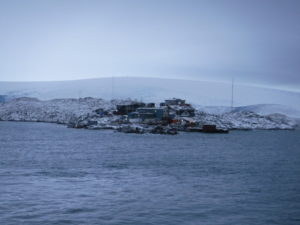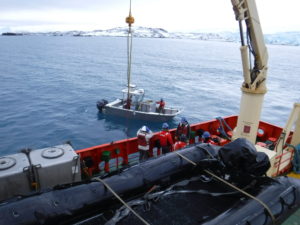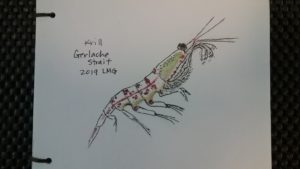Palmer Station Pit Stop

We arrived at Palmer Station this morning (picture above, Happy Easter!), and are currently offloading supplies and fresh food for the station. The first thing(s) to come off the ship were the tanks of juvenile krill that the Bernard lab group will be studying at Palmer (image below shows one of the large grey tanks on small boat). The team will actually be at the station until October – which means they are “wintering over”. My two months away seemed like a long time until I heard this – actually, two months is still a long time.

I promised that I’d say more about the krill fishing and why they were doing it. They use a very large net (not teeny tiny hooks, mom) with a bucket-like container on the end (called a cod end – no, I don’t know why. Google it, I only get 400 MB a day for internet access). The net is lowered and raised from the water with a winch. We often do smaller net tows over the side of the ship by hand, and you’ll get to see some of that later in the cruise. They had to fish for krill at night because that is when the animals seem come into the upper water column to feed. After the net comes back onboard the ship, the contents of the cod end are sorted through to select the juvenile krill. They collected thousands. These animals were transferred to tanks that held several hundred liters of flowing seawater. The flowing seawater keeps the animals at their ambient temperature, perhaps provides a little bit of food, and also washes away waste products. That last bit becomes important when there are several thousand animals in one tank – even though they are small and the water volume seems very large, it can become dirty very quickly.

What are they going to do with all of these krill? They are going to examine how differences in what they eat influence their growth and survival in the Antarctic winter. This is important with respect to the rapid and dramatic changes being observed in sea ice and in the types of phytoplankton that are present, particularly around the Palmer peninsula region. Krill feed on diatoms on the bottom of the ice, in addition to other phytoplankton, and are the “next step” up in the planktonic food web. Microscopic single celled algae, called phytoplankton, are the “grass” of aquatic environments. They provide food for organisms higher in the food web, who then are eaten by other (usually larger) organisms. Without phytoplankton we don’t get krill, and without krill we don’t get whales. Everyone likes whales, right? BTW, two humpbacks surfaced within 10 ft of the back deck when we were working outside yesterday! And we watched a seal play in the water – but I know not everyone likes seals. Sorry, no pictures of either of those, but I did a drawing of a krill, and pulled out my watercolors to make it pretty.

Regarding our own project, we were actually busy yesterday. We got some surface water and ran through all of our sampling and experimental protocols to see how long they took and how to organize the work flow (no matter how many times you do it, it’s always different). It took us from about 9 am until mid-afternoon to get finished with everything. We still need to finish the ingestion counts by microscopy, but this afternoon we are going to take a tour of Palmer station. This evening we can sit at the microscope, and it will be extra nice because the ship is very stable right now because we are moored at the station. It will be much more of a challenge when we are back at sea, especially since looking through the scope can bring on or aggravate seasickness.